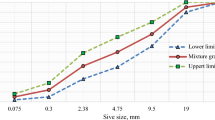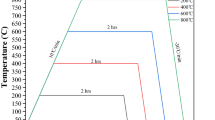Abstract
In the present work, the effect of SiO2 and Al2O3 nanoparticles on compressive strength of ash-based geopolymers with different mixtures of rice husk ash, fly ash, nanoalumina and nanosilica has been predicted by gene expression programming. The models were constructed by 12 input parameters, namely the water curing time, the rice husk ash content, the fly ash content, the water glass content, NaOH content, the water content, the aggregate content, SiO2 nanoparticle content, Al2O3 nanoparticle content, oven curing temperature, oven curing time and test trial number. The value for the output layer was the compressive strength. According to the input parameters in gene expression programming models, the data were trained and tested, and the effects of SiO2 and Al2O3 nanoparticles on compressive strength of the specimens were predicted with a tiny error. The results indicate that gene expression programming model is a powerful tool for predicting the effect of nanoparticles on compressive strength of the geopolymers in the considered range.






Similar content being viewed by others
Change history
15 April 2020
The Editor-in-Chief has retracted this article because it significantly overlaps with a number of articles including those that were under consideration at the same time and previously published articles. Additionally, the article shows evidence of peer review manipulation. The authors have not responded to any correspondence regarding this retraction.
References
Poulesquen A, Frizon F, Lambertin D (2011) Rheological behavior of alkali-activated metakaolin during geopolymerization. J Non-Cryst Solids 357:3565–3571
Pacheco-Torgal F, Castro-Gomes JP, Jalali S (2008) Investigations on mix design of tungsten mine waste geopolymeric binder. Constr Build Mater 22:1939–1949
Nazari A, Riahi S (2010) Microstructural, thermal, physical and mechanical behavior of the self compacting concrete containing SiO2 nanoparticles. Mater Sci Eng A 527:7663–7672
Nazari A, Riahi S (2011) Improvement compressive strength of concrete in different curing media by Al2O3 nanoparticles. Mater Sci Eng A 528:1183–1191
Riahi S, Nazari A (2012) The effects of nanoparticles on early age compressive strength of ash-based geopolymers. Ceram Int 38:4467–4476
Nazari A, Riahi S (2012) Prediction of the effects of nanoparticles on early-age compressive strength of ash-based geopolymers by fuzzy logic. Int J Damage Mech. doi:10.1177/1056789512442519
Cevik A, Sonebi M (2009) Genetic programming based formulation for fresh and hardened properties of self-compacting concrete containing pulverised fuel ash. Constr Build Mater 23(7):2614–2622
Milani AA, Nazari A (2012) Modeling ductile-to-brittle transition temperature of functionally graded steels by gene expression programming. Int J Damage Mech 21(4):465–492
Nazari A, Khalaj G, Didehvar N (2012) Computational investigations of the impact resistance of aluminum-epoxy laminated composites. Int J Damage Mech 21(5):623–646
Cevik A, Guzelbey İH (2007) A soft computing based approach for the prediction of ultimate strength of metal plates in compression. Eng Struct 29(3):383–394
Cevik A, Sonebi M (2008) Modelling the performance of self-compacting SIFCON of cement slurries using genetic programming technique. Comput Concr 5:475–490
Cevik A (2007) A new formulation for longitudinally stiffened webs subjected to patch loading. J Constr Steel Res 63:1328–1340
Nazari A (2012) Experimental study and computer-aided prediction of percentage of water absorption of geopolymers produced by waste fly ash and rice husk bark ash. Int J Miner Process 110–111:74–81
Chanh NV, Trung BD, Tuan DV (2008) Recent research geopolymer concrete. In: The 3rd ACF international conference—ACF/VCA
Sathia R, Babu KG, Santhana M (2008) Durability study of low calcium fly ash geopolymer concrete. In: The 3rd ACF international conference—ACF/VCA
Alvarez-Ayuso E, Querol X, Plana F, Alastuey A, Moreno N, Izquierdo M, Font O, Moreno T, Diez S, Vazquez E, Barra M (2008) Environmental, physical and structural characterization of geopolymer matrixes synthesized from coal (co-)combustion fly ashes. J Hazard Mater 154:175–183
Koza JR (1992) Genetic programming: on the programming of computers by means of natural selection. MIT Press, Cambridge
Rosenblatt F (1962) Principles of neuro dynamics: perceptrons and the theory of brain mechanisms. Spartan Books, Washington, DC
Rumelhart DE, Hinton GE, William RJ (1986) Learning internal representation by error propagation. In: Rumelhart DE, McClelland JL (eds) Proceeding parallel distributed processing foundation, vol 1. MIT Press, Cambridge
Liu SW, Huang JH, Sung JC, Lee CC (2002) Detection of cracks using neural networks and computational mechanics. Comput Meth Appl Mech Eng 191(25–26):2831–2845
Anderson JA (1983) Cognitive and psychological computation with neural models. IEEE Trans Syst Man Cybern V.SMC-13 5:799–814
Hopfield JJ (1982) Neural networks and physical systems with emergent collective computational abilities. Proc Nat Acad Sci 79:2554–2558
Cevik A, Sonebi M (2009) Genetic programming based formulation for fresh and hardened properties of self-compacting concrete containing pulverised fuel ash. Constr Build Mater 23(7):2614–2622
Topcu IB, Sarıdemir M (2008) Prediction of compressive strength of concrete containing fly ash using artificial neural network and fuzzy logic. Comp Mater Sci 41(3):305–311
Author information
Authors and Affiliations
Corresponding author
Additional information
The Editor-in-Chief has retracted this article because it significantly overlaps with a number of articles including those that were under consideration at the same time and previously published articles. Additionally, the article shows evidence of peer review manipulation. The authors have not responded to any correspondence regarding this retraction.
About this article
Cite this article
Nazari, A., Riahi, S. RETRACTED ARTICLE: Predicting the effects of nanoparticles on compressive strength of ash-based geopolymers by gene expression programming. Neural Comput & Applic 23, 1677–1685 (2013). https://doi.org/10.1007/s00521-012-1127-7
Received:
Accepted:
Published:
Issue Date:
DOI: https://doi.org/10.1007/s00521-012-1127-7




